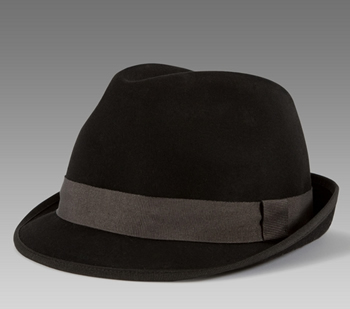Take a photo of a barcode or cover
Ultimately this was worth reading for (a) the origin of the reference “Svengali” (but does anyone even use that term anymore?) and (b) its nostalgic look at la vie Bohème in 1850s Paris which du Maurier (grandfather to Daphne) experienced firsthand in his youth. Certainly the books popularity when it was published in 1894 must have been in part due to its scandalous depiction of bohemian life with its more casual mores about sex and nudity compared to that of Victorian England.
Three young men share a Left Bank studio in Paris where they meet Trilby, the beautiful, jejune orphan who models for painters and sculptors. All three are in love with Trilby, but especially Little Billee, whose love she returns. Unfortunately, she has also caught the eye of the manipulative musician Svengali. Events conspire to tear the young lovers apart and to bring Trilby under the sway of Svengali.
I am glad to have read it but it was a bit meandering; there was lots of description that slowed me down, not to mention the untranslated French, not to mention the untranslated French written phonetically in a German accent. Whew! Also, it is very anti-Semitic. Svengali, like Fagin in Oliver Twist is not bad and a Jew, he is bad because he is a Jew.
Three young men share a Left Bank studio in Paris where they meet Trilby, the beautiful, jejune orphan who models for painters and sculptors. All three are in love with Trilby, but especially Little Billee, whose love she returns. Unfortunately, she has also caught the eye of the manipulative musician Svengali. Events conspire to tear the young lovers apart and to bring Trilby under the sway of Svengali.
I am glad to have read it but it was a bit meandering; there was lots of description that slowed me down, not to mention the untranslated French, not to mention the untranslated French written phonetically in a German accent. Whew! Also, it is very anti-Semitic. Svengali, like Fagin in Oliver Twist is not bad and a Jew, he is bad because he is a Jew.
Read as part of my A2 English Literature Gothic Coursework. I chose this book as my third text to study and I'm so glad I did. I really loved the story and characters and it was a surprisingly intriguing read. It's not a typical Gothic novel but Svengali is a brilliant villain and all of the characters are so well written. I also really enjoyed reading about Du Maurier and his life, children and the literary world he surrounded himself in.
Enjoyable, readable Victorian high melodrama, with an uncomfortable anti-Semitic undertone
The beginning was a little slow, and I have mega-mixed feelings on the way the story is told. At times, du Maurier shows the reader just how skilled he is with language. His command over language has you searching in dictionaries for obscure turns of phrase. He also weaves beautifully constructed phrases, sentiments, and ideas. However, the story seems to, at times, sit on the surface. Emotion is there, but it sits behind a glass door. Perhaps, this is the point. Just as Trilby shows her emotions at the beginning, it is only *SPOILERS NOW* when we have two Trilby's that her "feeling' is taken, widely, as legitimate. As a poor, parentless, model to the bohemian artists of mid-nineteenth-century France, she is conceived of as needing to be taught things. It might be true that we can always do with being taught things, but her character is seen as somehow lacking. But when her character is filled by the dominating power of Svengali's self-love (not that kind you perv) then her character becomes worthy. The author critiques the turn of events in the novel as if he has no control over them--he merely records. Litrebili, through is mother and uncle's actions, leaves Trilby alone--abandons her. Of course, he suffers as well. And, I will say that the book does a spectacular job at examining mental illness as a disease of the body and not just emotions gone wild. People seem to respect that one cannot just "cheer up". In any case, the book is much more than the Svengali we have been told about. The beginning might be a little slow, but it's merely because the author colours it will really niche references that can, sometimes, be a little dull--moreso because it skirts over many things than developing particulars. Although, I respect this choice since the author seems to be trying to give us as much information about the bohemian scene--so, as a source it's quite giving. Enjoy, and be ready to have a French-English dictionary available---it's worth it.
Free download available at Project Gutenberg.
This book was published serially in Harper’s Monthly in 1894.
This is the story of Trilby O’Ferrall, an half-Irish girl working in Paris as an artist model and laundress. There she meets Svengali, a Jewish hypnotist who teaches her to sing since she is tone-deaf. In Paris, she meets Little Billee and fails in love with him but she cannot stay with him since he belongs to a higher social class. Later on, he will become a famous artist in London. After a love disillusion, Billee returns to Paris and meets both Trilby and Svengali.

Trilby, hypnotized by Svengali. Svengali exaggerated features were typical of anti-Semitic portrayals of Jews at the turn of the century. This engraving was done by Du Maurier himself for the first edition of the novel in 1894.
According to Wiki, this book has inspired Gaston Leroux’s novel.
The novel has been adapted to the stage several times. During one of these plays, an actress wearer a short-brimmed hat with a sharp snap to the back of the brim, thus giving the name of the well-known hat “trilby”:

George du Maurier was the father of the actor Gerald du Maurier and grandfather of the writers Angela and Dame Daphne du Maurier. He was also the father of Sylvia Llewelyn Davies and grandfather of 5 boys who inspired J.M. Barrie’s Peter Pan. He wrote several cartoons in Punch.

This book was published serially in Harper’s Monthly in 1894.
This is the story of Trilby O’Ferrall, an half-Irish girl working in Paris as an artist model and laundress. There she meets Svengali, a Jewish hypnotist who teaches her to sing since she is tone-deaf. In Paris, she meets Little Billee and fails in love with him but she cannot stay with him since he belongs to a higher social class. Later on, he will become a famous artist in London. After a love disillusion, Billee returns to Paris and meets both Trilby and Svengali.

Trilby, hypnotized by Svengali. Svengali exaggerated features were typical of anti-Semitic portrayals of Jews at the turn of the century. This engraving was done by Du Maurier himself for the first edition of the novel in 1894.
According to Wiki, this book has inspired Gaston Leroux’s novel
The novel has been adapted to the stage several times. During one of these plays, an actress wearer a short-brimmed hat with a sharp snap to the back of the brim, thus giving the name of the well-known hat “trilby”:

George du Maurier was the father of the actor Gerald du Maurier and grandfather of the writers Angela and Dame Daphne du Maurier. He was also the father of Sylvia Llewelyn Davies and grandfather of 5 boys who inspired J.M. Barrie’s Peter Pan. He wrote several cartoons in Punch.

This book really hasn't aged well.
It was interesting to see what a bestseller from that time is like and I'm glad I read it, I just really didn't enjoy it. It combines probably all of the things we're glad not to see in books anymore: antisemitism, over the top superficiality, terrible morals and framing that just doesn't feel right.
Reading this, I didn't feel that Little Billee was really a better person than Svengali, but Billee was the "hero" because he was a good looking English gentleman, framed as innocent, and Svengali was an ungly German Jew. What more is there to say. Similar things are used for a lot of characters in this book.
I know a lot of classics I like have pinches of problematic things, too, but they also have a lot of good elements that make me overlook them. This book, however, was actually kind of boring. What little story there was was ok, but nothing too special, however, most of the novel is comprised of meaningless accurences and descriptions. In the beginning, I had moments were I thought I might get to like the writing style, it had something to it, but I never really got into it.
The most fun I had with this book was when Svengali insulted someone in German :D However, I think du Maurier expected all his readers to be fluent in colloquial German and French, which was kind of annoying.
It was interesting to see what a bestseller from that time is like and I'm glad I read it, I just really didn't enjoy it. It combines probably all of the things we're glad not to see in books anymore: antisemitism, over the top superficiality, terrible morals and framing that just doesn't feel right.
Reading this, I didn't feel that Little Billee was really a better person than Svengali, but Billee was the "hero" because he was a good looking English gentleman, framed as innocent, and Svengali was an ungly German Jew. What more is there to say. Similar things are used for a lot of characters in this book.
I know a lot of classics I like have pinches of problematic things, too, but they also have a lot of good elements that make me overlook them. This book, however, was actually kind of boring. What little story there was was ok, but nothing too special, however, most of the novel is comprised of meaningless accurences and descriptions. In the beginning, I had moments were I thought I might get to like the writing style, it had something to it, but I never really got into it.
The most fun I had with this book was when Svengali insulted someone in German :D However, I think du Maurier expected all his readers to be fluent in colloquial German and French, which was kind of annoying.
DNF at 100 pages. I'm sorry, but I just can't do this. The story seems interesting enough in itself, but the antisemitism is just so rampant, and so very unnecessary to this story... I'm not going to make myself finish it. It would only anger me
A tragic romance with endearing characters. The only downside for me was the huge amount of tangents in it. The novel is littered with references that, to a contemporary reader, do little to contribute to the story (regardless of the giant number of explanatory notes at the back).
However, Du Maurier's illustrations are a major part of the book's appeal.
However, Du Maurier's illustrations are a major part of the book's appeal.



